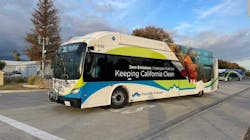U.S. aims to reach net-zero carbon emissions by 2050 under inter-agency blueprint
A blueprint developed by the U.S. Departments of Energy (DOE), Transportation (USDOT), Housing and Urban Development and the Environmental Protection Agency (EPA) seeks to secure a 100 percent clean electrical grid by 2035 and achieve net-zero carbon emissions by 2050.
The release of the U.S. National Blueprint for Transportation Decarbonization is the first deliverable following last year’s inter-department memorandum of understanding. The blueprint will be followed by detailed decarbonization action plans in cooperation with state, local and tribal governments, as well as private and global partners.
Globally, the U.S. is a part of several commitments to lower emissions. In November 2022, the U.S. signed the Global Memorandum of Understanding on Zero-Emission Medium-and Heavy-Duty Vehicles at COP27, which is an international agreement that supports a path to 100 percent new zero-emission medium- and heavy-duty vehicle sales by 2040. The same day the blueprint was released, President Joe Biden, President Andrés Manuel López Obrador of Mexico and Prime Minister Justin Trudeau of Canada shared the results of the North American Leaders’ Summit, which outlines shared priorities among the countries and included a commitment to share information between countries on best practices to electrify and decarbonize public buses through the cooperative development of a Joint Transit Decarbonization Toolkit.
The domestic transportation sector accounts for one third of all domestic greenhouse gas emissions, and the joint statement from the departments notes transportation costs are the second largest annual household expense, which places a disproportionate and unsustainably high financial burden of transportation on residents with low incomes.
“The domestic transportation sector presents an enormous opportunity to drastically reduce emissions that accelerate climate change and reduce harmful pollution,” said U.S. Secretary of Energy Jennifer M. Granholm. “DOE is prepared to implement this blueprint alongside our partners within the Biden-Harris Administration to ensure all Americans feel the benefits of the clean transportation transition: Good-paying manufacturing jobs, better air quality and lower transportation costs.”
The blueprint focuses on three strategies that the departments say will deliver short-term and long-term results:
- Increase convenience by supporting community design and land-use planning at the local and regional levels that ensure job centers, shopping, schools, entertainment and essential services are strategically located near where people live to reduce commute burdens, improve walkability and bikeability and improve quality of life.
- Improve efficiency by expanding affordable, accessible, efficient and reliable options like public transportation and rail and improving the efficiency of all vehicles.
- Transition to clean options by deploying zero-emission vehicles and fuels for cars, commercial trucks, transit, boats, airplanes and more.
Regarding transit, the blueprint aims to see 30 percent of new vehicles sales of buses be zero-emission by 2030 and 100 percent by 2040. For rail, the blueprint will focus resources to develop a pathway toward zero-emission vehicle targets and encourage greater use of passenger rail.
The report recognizes there has been a move away from traditional transit use and an increase in more mobility options including bikeshare, rideshare and scooters.
“While there is uncertainty in demand growth for future passenger and freight mobility, there is also an opportunity to help shape that future to provide more options to reduce vehicle miles traveled while increasing mobility options and accessibility, improving quality of life and reducing emissions. Leveraging these opportunities can influence future travel demand and contribute to a more sustainable transportation future,” the report reads.
The blueprint emphasizes the transition to zero-emission vehicles, including buses, but also recognizes the importance of urban planning, increased access to transit systems and expanding and integrating mobility services as ways to help achieve the net-zero goals of the blueprint.
“Transportation policy is inseparable from housing and energy policy, and transportation accounts for a major share of U.S. greenhouse gas emissions, so we must work together in an integrated way to confront the climate crisis,” said U.S. Secretary of Transportation Pete Buttigieg. “Every decision about transportation is also an opportunity to build a cleaner, healthier, more prosperous future. When our air is cleaner, when more people can get good-paying jobs, when everyone stays connected to the resources they need and the people they love, we are all better off.”
The full blueprint can be found on the U.S. Department of Energy's website.
About the Author

Mischa Wanek-Libman
Group Editorial Director
Mischa Wanek-Libman is director of communications with Transdev North America. She has more than 20 years of experience working in the transportation industry covering construction projects, engineering challenges, transit and rail operations and best practices.
Wanek-Libman has held top editorial positions at freight rail and public transportation business-to-business publications including as editor-in-chief and editorial director of Mass Transit from 2018-2024. She has been recognized for editorial excellence through her individual work, as well as for collaborative content.
She is an active member of the American Public Transportation Association's Marketing and Communications Committee and served 14 years as a Board Observer on the National Railroad Construction and Maintenance Association (NRC) Board of Directors.
She is a graduate of Drake University in Des Moines, Iowa, where she earned a Bachelor of Arts degree in Journalism and Mass Communication.
